13+Employee Termination Letter
-

Employee Termination Letter due to Poor Performance
download now -

Restaurant Employee Termination Letter
download now -
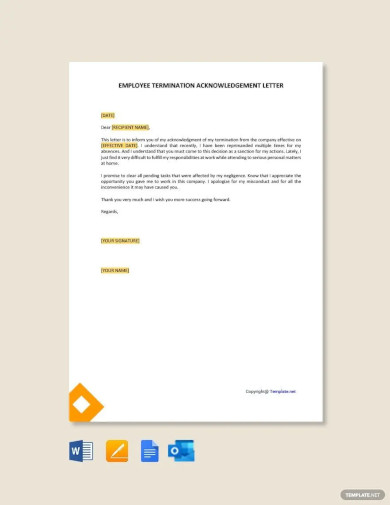
Employee Termination Acknowledgement Letter
download now -

Letter to Employee for Notice of Termination
download now -
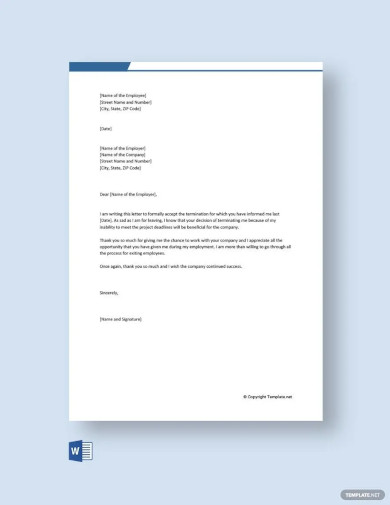
Termination Acceptance Letter by Employee
download now -

Employee Termination Letter
download now -
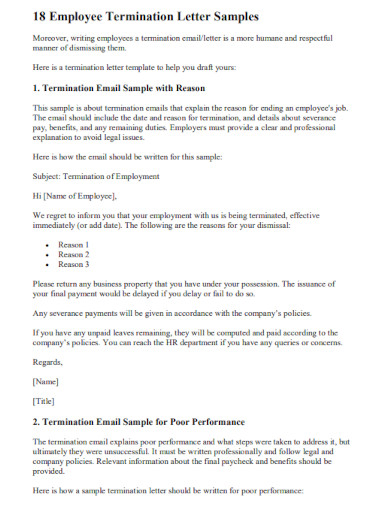
Employee Termination Letter Samples
download now -
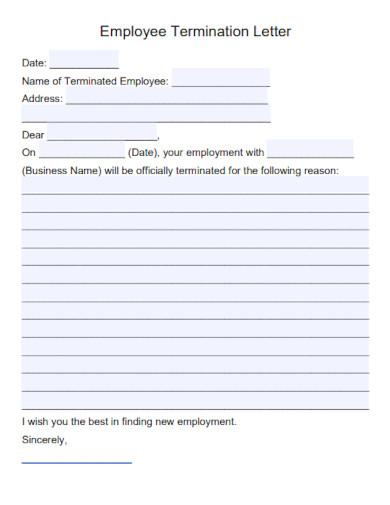
Simple Employee Termination Letter
download now -
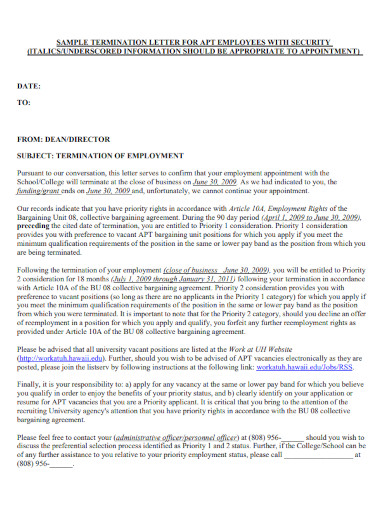
Termination Letter for Apartment Employees
download now -
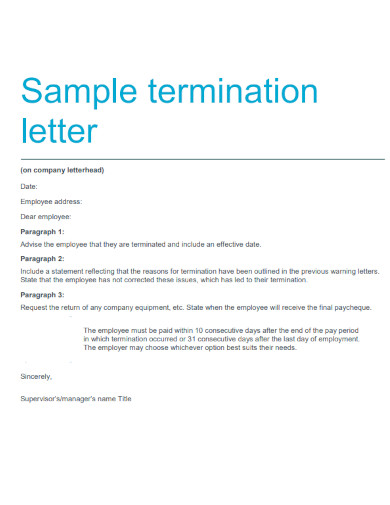
Company Employee Termination Letter
download now -
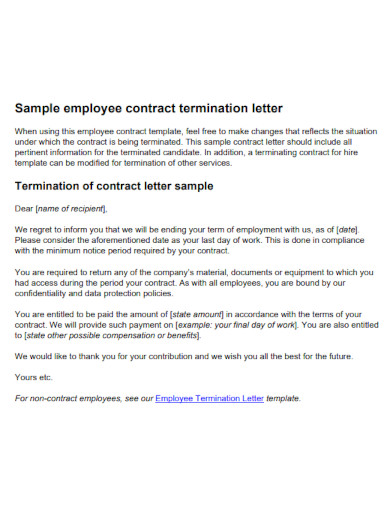
Employee Contract Termination Letter
download now -
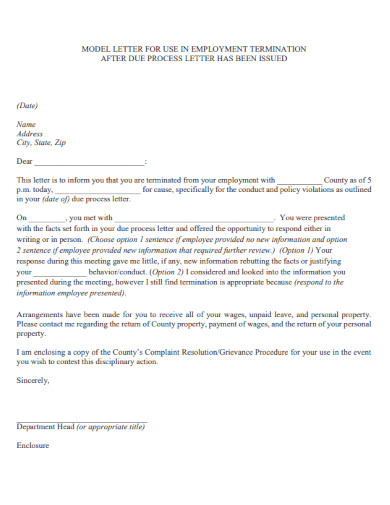
Employee Termination Model Letter
download now -
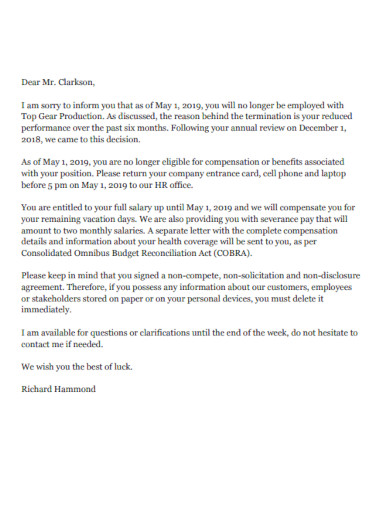
Termination of Employee Employment Letter
download now -
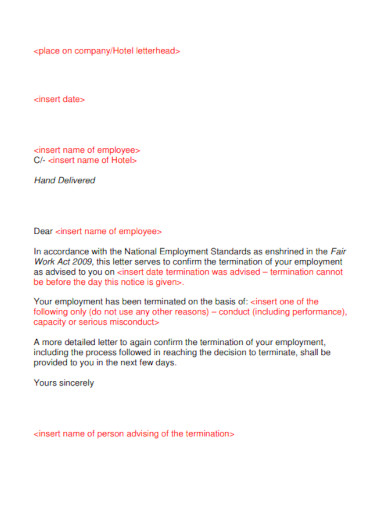
Hotel Employee Termination Letter
download now
FREE Employee Termination Letter s to Download
13+Employee Termination Letter
What Is a Termination Letter?
Benefits of Termination Letters
Tips to Fire an Employee Gracefully
How to Write an Employee Termination Letter
FAQs
Is it termination or resignation?
Does terminated mean fired?
Can you terminate a regular employee?
What Is a Termination Letter?
A termination letter from an employer to a worker contains relevant information about the employee’s termination. Typically, it serves as a formal notice to the employee and an official termination record. Termination letters are also understood as termination, dismissal, and termination notices. Although less common today, the term “pink slip” may refer to a termination letter delivered on the pink layer of a triplicate form. While no legal requirement exists to create or provide a termination letter, a comprehensive and detailed letter can prevent a former employee from claiming they were fired without cause or knowledge. Suppose a termination letter includes the reasons for an employee’s dismissal. In that case, it can also be used as evidence that the employee was terminated for a valid reason, although it is not a defence against a wrongful termination lawsuit.
Benefits of Termination Letters
Human resource officers and administrators utilize a termination letter as an essential tool for terminating employment. While not all states require written termination notices, one helps managers explain why they sever ties with an employee and documents issues that help employers demonstrate that the termination was lawful and just. A termination letter may be essential for the following reasons:
Tips to Fire an Employee Gracefully
Firing an employee is one of the most challenging decisions a business owner must make. Someone may not be a suitable fit for your team or may perform poorly. Regardless of the reason for their dismissal, no one wishes to be the one to deliver the bad news that they are being fired. Despite the difficulty of terminating an employee, the following suggestions can ensure that the process goes as efficiently as possible for all parties involved.
1. Offer Development Opportunities Beforehand
When a problem arises with any aspect of an employee’s performance, it’s likely that a series of events forced you to make a difficult decision. This is why frequent check-ins and performance evaluations at least twice a year can assist you in being transparent with your employees regarding their progress and areas for improvement. Except in cases where an employee has violated company policy, termination should always be a last resort. A performance improvement plan (PIP) can be utilised as a probationary period to help your employee meet objectives they may be struggling to attain or curb poor workplace behaviours while documenting their progress. You may also find it helpful to solicit feedback evaluation from other team members regarding your employee’s performance – have there been frequently missed deadlines, projects that require revision, or are they incapable of accepting feedback? Documenting the experiences of other team members can support your case for why an employee needs to improve or bring to light underlying issues. No one should be caught off guard by a termination – you should give your employee ample time to enhance their performance.
2. Consider HR a Witness
You, the employee, and a human resources representative should be present when terminating an employee. Someone from HR can help ensure that employees are treated fairly during the termination, keep discussions on track, and act as a witness if anything escalates, such as if the police need to be called or if the employee sues your company for unlawful termination. Working with HR can also be beneficial for ensuring impartiality and adherence to correct procedures. Employers are prohibited from removing workers based on age, race, religion, disability, national origin, pregnancy, or impending medical leave.
3. Meet Face-To-Face
It can be an extremely emotional experience to get fired. Regardless of why you must let an employee go, they deserve to hear the news in person. You should not call, text, email, or leave a voicemail telling your employee about your choice. A video meeting will be the best alternative if a face-to-face encounter is impossible due to COVID-19 constraints or if the person is a freelancer or contractor. Ensure you remain in the room or video call after breaking the news. You should be ready with specific examples of the circumstances that influenced your choice and be able to respond to inquiries concerning severance, the last salary, unused vacation time, retirement plans, and health insurance.
4. Keep It Concise, Formal, and Unambiguous
Ensure your dialogue with your employee is concise and straightforward. Avoid making small chats at the beginning of the meeting since you want to avoid the casual tone and then catch your employee off guard with the bad news. Ensure your employee leaves with a clear understanding of why they are being let go and what circumstances contributed to the decision. Refrain from giving hints that the decision is not final. If an employee is impeding the expansion and success of the business, but you want to avoid firing them since you like them, it is possible. You may find it challenging to break the news to your employee and hard to do so. Even if that’s the case, it’s crucial to ensure that you maintain your composure and stay professional despite how difficult it may be. You want to ensure everyone knows you value your employees personally, not just the individual you are firing. Offer your support, suggestions, and best wishes.
How to Write an Employee Termination Letter
Composing a termination letter can be difficult, but it is essential to terminate an employment relationship. In this section, we will examine the components of a typical termination letter in greater detail. Please note that this is an incomplete guide. Although everything listed below is appropriate for a termination letter, remember that workers may have rights to health and unemployment benefits after the employment relationship has ended. Your organization is responsible for adhering to your region’s labour laws and legal requirements. Still, these obligations may vary based on local regulations and the reason for the termination.
1. Choose Your Tone With Consideration
Letters of termination are a necessary component of the employee lifecycle. Regardless of whether employees must be laid off or terminated for misconduct, it is essential to maintain professionalism and courtesy in all official communications. Consider that if the termination is unanticipated, you will sever an employee’s income statement, health coverage, and other essentials while placing them in an uncertain situation. Although the company is not ultimately responsible for an employee’s well-being, you should be aware of these circumstances before initiating the conversation and demonstrate appropriate compassion. Your termination letter should also provide clear and actionable next steps, where applicable, to assuage some of this uncertainty.
2. Gather All Pertinent Information
Before writing a termination letter, take a moment to assemble the essential information you’ll need to complete the task. This information will differ for each employee based on their tenure with the organization and specific responsibilities. In certain situations, you may only require some items. Suppose you’re issuing a notice of termination to a freelancer or contracted employee. In that case, termination may be as simple as communicating the last day of employment and allowing the contractor sufficient time to complete any outstanding work.
3. Start With Fundamental Details
Start your letter of termination with the employee’s name and job title. If your organization is sufficiently large, you may also need to include employee ID, department, and manager or administrator information. This data can be presented as a list at the head of the page. It should be obvious, specific, and uncomplicated to identify the intended recipient of this information.
4. Communicate the Employee’s Termination Date
The date of termination’s effective date is among the most crucial details. This should be included early in the letter to establish clear limits for future business operations. In cases where an employee is terminated for cause, the termination date may be the same day as the letter’s issuance. Other times, particularly during layoffs and situations where you have no reason to terminate an employee, you may issue an end date months in advance to give employees time to prepare.
5. Indicate the Reason For Dismissal
From the employee’s perspective, the reason for termination may be the most essential aspect of the entire process, as it explains why they were terminated. This section should be plain, straightforward, and honest. You may refer to previous written warnings or months of compiled documentation if an employee is closed due to poor performance review. More urgent issues, such as assault or theft, may also be listed and are acceptable grounds for termination. Regardless of the reason for termination, describe these issues clearly so that the employee understands why they were let go. If the reason for termination is a specific or ongoing incident, provide explicit details. Be prepared to discuss these issues with your departing team member if you deliver this letter in person.
6. Describe Future Compensation and Benefits
Even in the event of a termination for cause, outgoing employees will still be eligible for certain benefits, and you must include the pertinent information in the termination letter. Companies may provide severance packages in addition to a pink notice. Occasionally, these are detailed or contingent upon an NDA. You should be prepared to examine these topics if they arise. Similarly, if an employee has accrued paid time off (PTO) or medical leave that is payable, mention it in this section. If your company offers COBRA or comparable health plans that extend coverage above the employment contract, you can also include information about these benefits here.
7. Describe Subsequent Steps and Disclaimers
Depending on the nature of the termination, you may be required to provide instructions for the next steps. In the event of an imminent, involuntary termination, security may be present to assist a disgruntled employee in leaving the building. Consider providing a work schedule to help employees close out existing contracts, transfer responsibilities to other team members, and depart with minimal team disruptions for terminations negotiated over time. Human resources may have a policy tracing the processes and procedures to track when establishing timelines for leaving employees; therefore, it is essential to consult existing policies when creating this section.
FAQs
Is it termination or resignation?
When an employee resigns, they quit their position on their own accord. In contrast, if an employer terminates an employee without cause, the employer terminates the employment relationship.
Does terminated mean fired?
Terminating refers to being dismissed. On the other hand, a layoff typically affects multiple individuals simultaneously and is caused by company changes, restructuring, acquisitions, financial difficulties, business model pivots, economic downturns, etc.
Can you terminate a regular employee?
Employers may terminate an employee for justifiable and authorized reasons. Just causes are founded on an employee’s wrongful actions or negligence, whereas authorized causes are legal grounds for termination that do not stem from the employee’s fault or negligence.
And there, you have all the information you need to write the perfect termination letter to employees. Creating termination letters for employment can be difficult, but templates simplify the process! This will not only make your business documentation appear more formal, but it will also expedite the process of creating documentation for your team.
